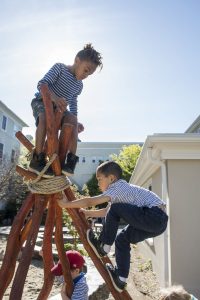 Male teachers are a rarity in American elementary schools, in pre-kindergarten and kindergarten education, especially. According to data compiled by the U.S. Bureau of Labor Statistics, of the more than 600,000 preschool and kindergarten teachers in the U.S. in 2014, less than three percent were men.
Male teachers are a rarity in American elementary schools, in pre-kindergarten and kindergarten education, especially. According to data compiled by the U.S. Bureau of Labor Statistics, of the more than 600,000 preschool and kindergarten teachers in the U.S. in 2014, less than three percent were men.
So, as a male kindergarten teacher, Fessenden’s Keith Fortier has a unique perspective. Keith spends most of his time helping others learn, but along the way, he has learned a few things himself.
We spoke with Keith recently about the lessons he has learned as a male teacher in the female-dominated field of early education.
Lesson 1: Boys (and men) learn differently from girls.
“Teachers naturally teach the way that they’re most comfortable learning. But to be a really good teacher, you need to step outside of yourself and consider other learning styles. At The Fessenden School, we’re very fortunate that we do have a collection of teachers—male and female—that really understand how boys learn.
“As a man, I identify strongly with the learning styles of the boys here. And I think our female teachers get it, as well. We have found that boys tend to be very experiential in their learning. Sometimes they don’t really want to understand something before they do it, they just want to do it.
“Many boys struggle to grasp what’s being taught if the teacher is just talking to them about it. To really understand something, these boys need to experience it, put their hands on it and do it.”
Lesson 2: For boys, risk-taking is often an essential part of learning.
 “One thing pre-K and kindergarten teachers at other schools may not realize is that, for many boys, risk is a huge part of learning—learning about themselves, learning about their environment, and learning about boundaries. I have helped the other teachers at Fessenden incorporate this idea into their teaching approaches.
“One thing pre-K and kindergarten teachers at other schools may not realize is that, for many boys, risk is a huge part of learning—learning about themselves, learning about their environment, and learning about boundaries. I have helped the other teachers at Fessenden incorporate this idea into their teaching approaches.
“I read about a study recently that put boys and girls in a stressful, simulated bike environment. Boys who had previously experienced a traumatic fall on a bike responded very well in the simulation. Boys who had not experienced a traumatic fall were nervous.
“This shows that risky situations can actually prepare boys for the future. Girls tend to be the exact opposite. Risky environments often make them shut down and feel they have to work back up to a certain level before they can handle those kinds of environments again.
“In schools where they don’t understand this, you see teachers stopping boys any time they push their boundaries. Really, that is shutting down learning for most boys, which is problematic for our future because we will have a whole generation of boys that can’t learn about themselves, learn about their world, and learn about their physical boundaries because their parents and teachers are not letting them take risks.
“Here at Fessenden, our general approach when we’re about to stop something that’s risky is to pause and ask ourselves, ‘Why do I want to stop this? Is it because I’m uncomfortable, or is it because this is a genuinely dangerous thing that should be ended?’ If it’s just because I’m uncomfortable, that’s not a good reason to stop whatever play is happening. If it actually is a dangerous moment, then it should be stopped.”
Lesson 3: Boys look to male teachers as role models.
“Many of the boys in my class don’t have a lot of adult men in their lives besides their fathers. Statistically, most people who choose to work with young children are women. So most of their teachers — Sunday school teachers, music class instructors, swim instructors — are women.
“I think that’s why many families seek out a school like Fessenden, where there are a lot of opportunities for me and other men to have a very good, positive impact on their sons’ lives.
“As a male kindergarten teacher, the opportunities to make an impact, to model how to be a gentleman, how to be a leader, how to be compassionate and caring, and how to be all the things that a man is are nearly infinite. I feel like the students here seek me out very quickly, and they want to know me. The connection is very natural, easy, and organic.”
About Keith Fortier
In addition to teaching kindergarten, Keith Fortier is a dorm parent in Hyde Hall and an Upper School lacrosse coach at Fessenden. Keith was also a part of the team of teachers and administrators that created Fessenden’s Pre-Kindergarten program – formulated its engaging curriculum, designed its creative classroom space and its leading-edge, ‘loose parts’ playground. Prior to joining the Fessenden Pre-K/K team, he served as the lead kindergarten teacher at Park Street Kids Inc. When he is not teaching, dorm parenting, or volunteering, Keith enjoys spending quality time with his wife and three children, Isabelle, Emmett, and Sheila Grace.
Where to Witness High-Quality Teachers in Action
One of the best ways to see the kind of difference a committed educator—male or female—like Keith can make in the lives of their young students is to tour the campus of a private pre-K or kindergarten program. To make the most of your tour, take a free copy of the Pre-K & Kindergarten Private School Visit Checklist with you.
If you have any questions for Keith about his experiences as a male teacher in a female-dominated vocation, please leave them in the comments section below.





Youre so cool! I dont suppose Ive learn anything like this before. So good to seek out any individual with some unique ideas on this subject. realy thanks for starting this up. this web site is one thing that is needed on the net, somebody with a bit originality. helpful job for bringing something new to the internet!